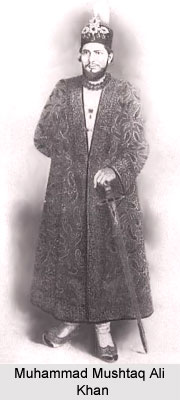 Muhammad Mushtaq Ali Khan, formally known as Nawab Muhammad Mushtaq Ali Khan Bahadur, KIH, was a well known and much respected ruler or Nawab of the princely state of Rampur. The princely state was later incorporated into the Indian state of Uttar Pradesh in the year 1949. He was born in the year 1856 and succeeded his father Sir Kalb Ali Khan Bahadur and ascended the throne after his father`s death in 1887. He belonged to the Rohilla Dynasty. Muhammad Mushtaq Ali Khan Bahadur ruled over the territory of Rampur from the year 1887 to 1889. Due to his continued illness and poor health, Mushtaq Ali was not capable to properly rule over the princely state of Rampur and thus left the affairs of the state in the competent hand of an administrative council. But still he was successful in continuing the beneficiary of his predecessors, principally in the areas of agriculture and irrigation.
Muhammad Mushtaq Ali Khan, formally known as Nawab Muhammad Mushtaq Ali Khan Bahadur, KIH, was a well known and much respected ruler or Nawab of the princely state of Rampur. The princely state was later incorporated into the Indian state of Uttar Pradesh in the year 1949. He was born in the year 1856 and succeeded his father Sir Kalb Ali Khan Bahadur and ascended the throne after his father`s death in 1887. He belonged to the Rohilla Dynasty. Muhammad Mushtaq Ali Khan Bahadur ruled over the territory of Rampur from the year 1887 to 1889. Due to his continued illness and poor health, Mushtaq Ali was not capable to properly rule over the princely state of Rampur and thus left the affairs of the state in the competent hand of an administrative council. But still he was successful in continuing the beneficiary of his predecessors, principally in the areas of agriculture and irrigation.
Personal Life of Muhammad Mushtaq Ali Khan
Nawab Muhammad Mushtaq Ali Khan Bahadur died on 25th February 1889 at the age of 32, and was succeeded by Sir Hamid Ali Khan Bahadur, who was his son.
Titles of Muhammad Mushtaq Ali Khan
Muhammad Mushtaq Ali Khan, Nawab of the princely state of Rampur held many titles. These are mentioned below-
* Nawabzada Muhammad Mushtaq Ali Khan, Wali Ahad Bahadur (1856- 1877)
* Nawabzada Muhammad Mushtaq Ali Khan, Wali Ahad Bahadur, KIH (1877- 1887)
* His Highness Ali Jah, Farzand-i-Dilpazir-i-Daulat-i- Inglishia, Mukhlis ud-Daula, Nasir ul-Mulk, Amir ul-Umara, Nawab Muhammad Mushtaq Ali Khan Bahadur, Mustaid Jang, Nawab of Rampur, KIH (1887- 1889)
Honours of Muhammad Mushtaq Ali Khan
Nawab Muhammad Mushtaq Ali Khan Bahadur was honoured with the Kaiser-i-Hind Silver Medal (KIH) in the year 1877.
This article is a stub. You may enrich it by adding more information to it. You can send your write-up at content@indianetzone.com



















